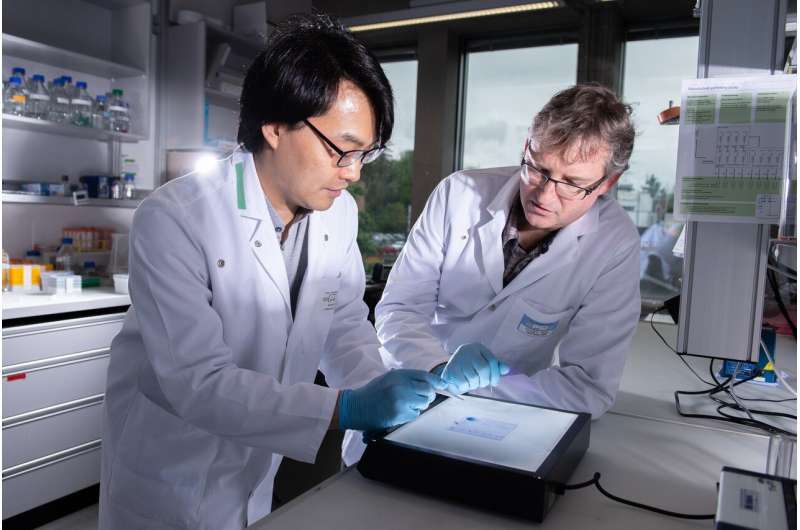Molecular scissors stabilize the cell's cytoskeleton

Researchers at the Paul Scherrer Institute PSI in Villigen, Switzerland, have for the first time elucidated the structure of important enzymes in human cells that alter essential building blocks of the cellular cytoskeleton. This reveals the missing part of a cycle that regulates the build-up or breakdown of supporting elements of the cell. The enzymes investigated work as molecular scissors and can be involved in the development of diseases, for example, cancer and diseases of the nervous system. Their structural elucidation provides approaches for the development of specific inhibitors and perhaps new therapies. The researchers gained detailed insights into the structure of the enzymes with the help of the Swiss Light Source SLS. They have now published their results in the journal Nature Structural & Molecular Biology.
The so-called microtubule filaments give human cells their shape, play a decisive role in cell division, and help to transport substances through the cell. The tasks they perform are of such central importance for life that they are found in the cells of all plants, animals and humans. Microtubules can grow up to several micrometers, which is roughly the thickness of an average human hair.
The tubular structure of microtubules consists of a regular arrangement of two building blocks, the so-called tubulins (α-tubulin and β-tubulin). In a healthy cell, new microtubules are constantly formed from these building blocks and are destroyed again. This process is regulated by numerous mechanisms, one of which is the so-called tubulin-tyrosine cycle. The amino acid tyrosine is either attached to the α-tubulin or cut off from it.
The enzymes that attach tyrosine to α-tubulin have been known for a long time. Without these enzymes, nerve cells cannot connect properly in the brain. The enzymes that remove tyrosine from α-tubulin, the so-called vasohibins, were not identified until 2017.
Studying molecular scissors at work
Cutting off the amino acid tyrosine from α-tubulin usually stabilises microtubules. Without tyrosine, microtubules can remain intact for several hours, whereas the ones with tyrosine are usually broken down after a few minutes.
Researchers at the Paul Scherrer Institute PSI in Villigen have now report the exact structure of two vasohibins and how these enzymes remove the amino acid tyrosine from α-tubulin. For this purpose, the vasohibins form a groove in their molecular structure that fits perfectly to the tyrosine-bearing end of α-tubulin. In order for this active centre to fit exactly to its target structure, the enzyme also needs an activator, the so-called small vasohibin binding protein. This protein was previously only known as a stabiliser of vasohibins, but not as a stimulator of an enzymatic reaction. Precise structural analyses of the enzymatically active centre also show how inhibitors should look in order to inhibit vasohibins.
Another surprising result that the researchers achieved with their work: If the activity of the vasohibins is suppressed, disturbances occur in the development of nerve cells and their connections that are similar to those seen in the absence of their counterpart, the enzyme that attaches the amino acid tyrosine to α-tubulin. "A delicate balance between microtubules with and without tyrosine is the key for the normal formation of neurons," said Michel Steinmetz, head of the Laboratory for Biomolecular Research at PSI. "Our results clarify the structural basis of tubulin-detyrosination and clarify the relevance of this process for neuron development."
A possible route to new therapies
Since microtubules are involved in numerous other vital processes in the body in addition to the correct development of neuronal tissues, research on their formation and structure opens up new opportunities for medicine. For example, microtubules play an important role in the growth of tumours and the maintenance of healthy neurons. "With our structural elucidation of vasohibins in complex with inhibitors, we might now be able to develop novel types of drugs against diseases associated with unusual tubulin tyrosination, such as some cancers or possibly brain disorders," said Steinmetz.
With the structural elucidation of the vasohibins, it was possible for the first time to describe the complete tubulin-tyrosine cycle in detail. "This gives us completely new possibilities to intervene in this cycle with therapeutics and to develop new active substances for it," says Sung Ryul Choi, a biochemist at PSI and one of the first authors of the study.
To elucidate the structure of the vasohibins, the researchers used the Swiss Light Source SLS. "We were able to complete our structural work in about five months," said Choi. "This was only possible because here at PSI we have all the necessary expertise and infrastructure in one place."
More information: Structural basis of tubulin detyrosination by the vasohibin–SVBP enzyme complex, Nature Structural & Molecular Biology (2019). DOI: 10.1038/s41594-019-0241-y , www.nature.com/articles/s41594-019-0241-y
Journal information: Nature Structural & Molecular Biology
Provided by Paul Scherrer Institute




















